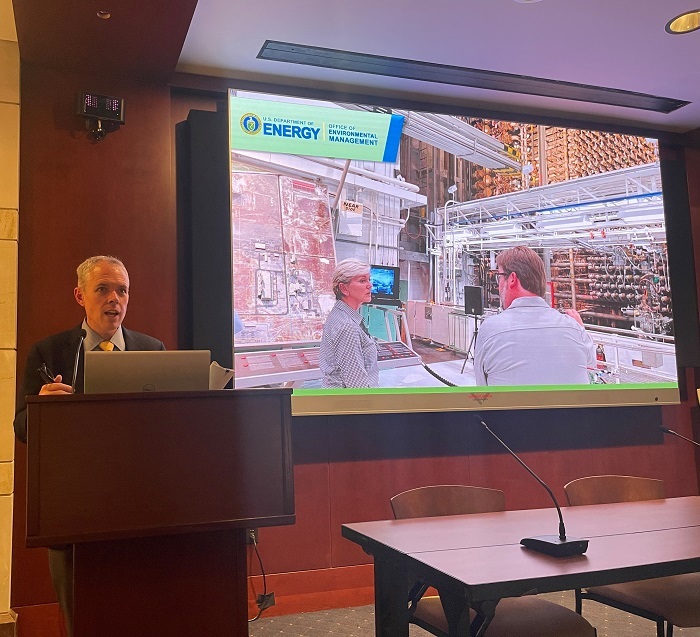 EM Senior Advisor William “Ike” White gives remarks during an event for the House Nuclear Cleanup Caucus last week.
Historic accomplishments, innovative technologies and additional treatment capabilities have ushered in a new era of cleanup progress that wouldn’t have happened without EM’s champions in Congress, EM Senior Advisor William “Ike” White said last week at the first event of the House Nuclear Cleanup Caucus since 2019.
“We’re building on that progress across the EM complex and are on track this year to complete the majority of 2022 priorities on time and on budget,” White said. "It’s important work, and so the work that’s required on [Capitol Hill] to ensure that we get funding to do that is also an incredible effort.”
White also told the audience at the U.S. Capitol Visitors Center in Washington, D.C. that he appreciates the members of the congressional cleanup caucus for their hard work “getting others in Congress to see the benefit of what we’re doing in the cleanup program.”
White pointed to several examples of EM successes from recent years, including the demolition of the X-326 uranium process building at the Portsmouth Site, completed three months ahead of schedule, and the launch of demolition of a former reactor facility at the Oak Ridge National Laboratory at Oak Ridge.
“You can already start to see the central campus at Oak Ridge changing in preparation for future missions we have at the laboratory,” White said.
EM’s progress across the country wouldn’t be possible without the strong support from members of the caucus and other entities, White said. Those entities include industry partners; local communities; highly skilled laborers and the unions that represent them; and organizations such as the Energy, Technology and Environmental Business Association, Energy Facility Contractors Group and Nuclear Energy Institute. Those three groups sponsored the caucus event.
White said cleanup progress has reached a point that enables EM to focus on clearing the decks.
“From developing the future workforce to resetting regulatory relationships to tackling Hanford tank waste, these are not easy decks to clear, but they set up our cleanup communities for a very bright future,” he said.
 |
|
Rep. Chuck Fleischmann of Tennessee, co-chair of the House Nuclear Cleanup Caucus. |
Rep. Susie Lee of Nevada, co-chair of the House Nuclear Cleanup Caucus. |
|
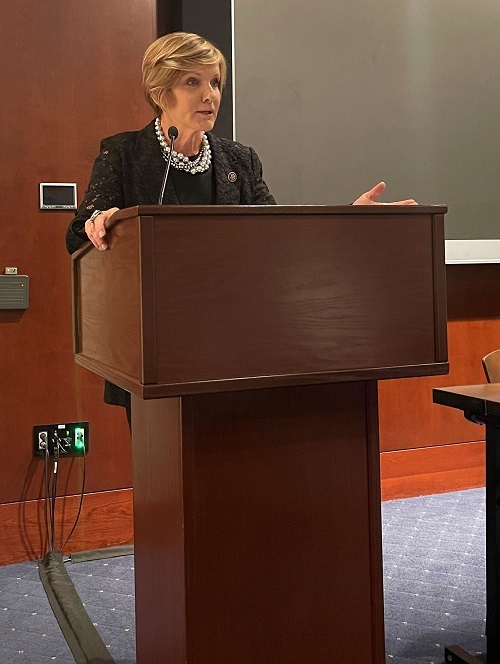 |
Reps. Chuck Fleischmann of Tennessee and Susie Lee of Nevada, caucus co-chairs, affirmed their support for the cleanup program.
“Thank you for your support. Thank you for the hard work,” Fleischmann said. “This is something that should be an American legacy. It’s an American government obligation and it’s just a privilege to serve in this capacity.”
Lee also stressed the importance of working together to complete EM’s cleanup mission.
“This is an issue that reaches across the aisle, touches many, many states in this country, and it’s simply something that we have to find a solution to and we have to work together on, and that’s why when Chuck asked me to co-chair the nuclear cleanup caucus, I was happy to accept that invitation because I think this work is so incredibly important,” Lee said.
Ken Rueter, president and CEO of UCOR, EM's cleanup contractor at Oak Ridge, and Mark Krauss, senior director for Stockpile Experimentation and Operations with Mission Support and Test Services, the Nevada National Security Site management and operations contractor, discussed how cleanup efforts are increasingly key to enabling vital national security and science missions.
-Contributor: David Sheeley
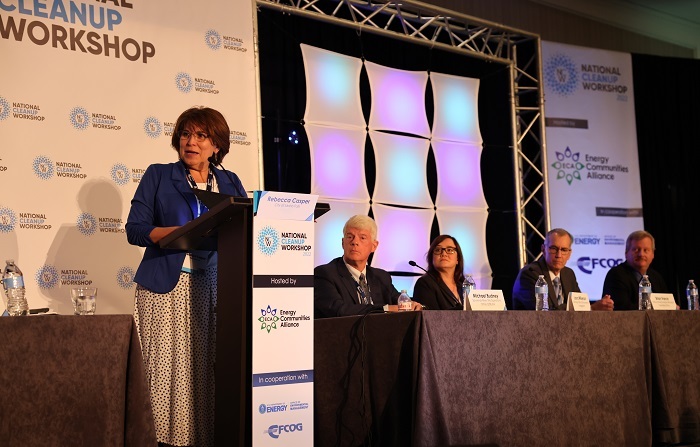 EM field office managers participated in a roundtable discussion at the National Cleanup Workshop. From left are City of Idaho Falls Mayor Rebecca Casper, moderator; DOE Savannah River Site Manager Mike Budney; Oak Ridge Office of Environmental Management Acting Manager Laura Wilkerson; Hanford Site Manager Brian Vance; and EM Consolidated Business Center Director Jack Zimmerman.
Eight managers leading cleanup at EM sites across the DOE complex highlighted successes and shared challenges over the past year during a roundtable discussion at the National Cleanup Workshop. Rebecca Casper, mayor of the City of Idaho Falls, Idaho, kicked off the discussion as moderator, telling the audience that EM’s field office managers truly embody the word “management” as they sit at the confluence of science, politics, finance, technology and media.
Carlsbad Field Office (CBFO) Manager Reinhard Knerr and Idaho Cleanup Project Manager Connie Flohr talked about the cross-cutting safety initiative they coordinated over the past year. With transuranic waste shipment numbers increasing back to pre-COVID-19-pandemic levels, Knerr and Flohr saw an opportunity to refocus their teams on safety and increase workforce efficiencies by sending team members from the Waste Isolation Pilot Plant and the Idaho National Laboratory Site to each other’s sites. The goal of that exercise was to integrate the workforces in hopes of linking project goals and experiences as well as provide a forum for team members from each site to share various experiences. Knerr said he is coordinating with the EM Los Alamos Field Office to conduct a similar effort in the near future.  Roundtable discussion participants from left include Portsmouth/Paducah Project Office Manager Joel Bradburne; Carlsbad Field Office Manager Reinhard Knerr; Idaho Cleanup Project Manager Connie Flohr; and EM Los Alamos Field Manager Michael Mikolanis.
DOE Savannah River Site (SRS) Manager Mike Budney discussed initiatives contractors at SRS have undertaken over the past year to procure the workforce needed by the site. Budney spoke about how SRS is rethinking the way the site has traditionally advertised job openings to find more candidates. Budney said an SRS contractor recently held a job fair and was able to make 135 job offers at the event. He said that demonstrates the importance of effective advertising when trying to acquire talent.
Joel Bradburne, manager for the Portsmouth/Paducah Project Office, shared the interesting dynamics of managing three different sites. Bradburne said that in the end, employees at all three sites want the same thing: they want a good livelihood, to feel like they are included and to feel like they are doing something useful and important. Bradburne said to meet those needs, as a site manager, it is important for him to routinely reach out to people to make them feel like they are part of a family. He noted that the pandemic led his team to embrace technology and virtual meetings, enabling them to more regularly get the word out on the program’s accomplishments.
EM Los Alamos Field Manager Michael Mikolanis, Hanford Site Manager Brian Vance and Knerr discussed the importance of regularly engaging with stakeholders. They shared with attendees various efforts each site has taken to enhance stakeholder engagement. The site managers emphasized that it is important for sites to be integrated within the communities they call home.
Oak Ridge Office of Environmental Management Acting Manager Laura Wilkerson and EM Consolidated Business Center Director Jack Zimmerman closed out the panel with a focus on community support clauses. Zimmerman said his team is making an effort to ensure that community support clauses are in every contract going forward. But he noted that all of EM’s support contractors have delivered on community support.
Wilkerson discussed how Oak Ridge’s support contractor has truly embraced partnering with Oak Ridge’s local communities. She said the partnerships that have been created are essential to the site’s success. It may be a lot of effort, but it is well worth it in the end and frankly, it is essential, Wilkerson added.
-Contributor: Patrick Hefflinger
 Kristen Ellis, EM's director for regulatory, intergovernmental and stakeholder engagement, speaks during the "Developing the Future EM Workforce" panel at the National Cleanup Workshop. At right is panelist JJ Chavez, a City of Carlsbad, New Mexico council member and Energy Communities Alliance Executive Board member.
A National Cleanup Workshop panel comprised of federal and contractor leaders and community stakeholders from across the DOE complex shared insights into succession planning to help develop EM’s future workforce.
EM has a workforce of about 33,000 federal and contractor employees. However, the cleanup program is expected to continue for decades, and that workforce is aging, with employees who are eligible, or soon to be eligible, for retirement. EM faces an incoming worker shortage unless measurable actions are taken.
- About 25% of the current EM workforce is eligible to retire presently.
- Approximately one-third of the workforce is eligible to retire in the next three years.
- Almost half of the workforce will be retirement-eligible in five years.
- Only 15 employees are under the age 30 in the EM federal complex-wide workforce of 1,200 employees.
EM leaders recognize recruitment and retention are vital to EM’s continued workforce development.
“We have so many different issues particularly prevalent in our industry. We can sit and come up with 50 or 60 things that we want to fix,” said Kristen Ellis, EM’s director for regulatory, intergovernmental and stakeholder engagement. “And incorporating each individual site perspective is also very challenging,”
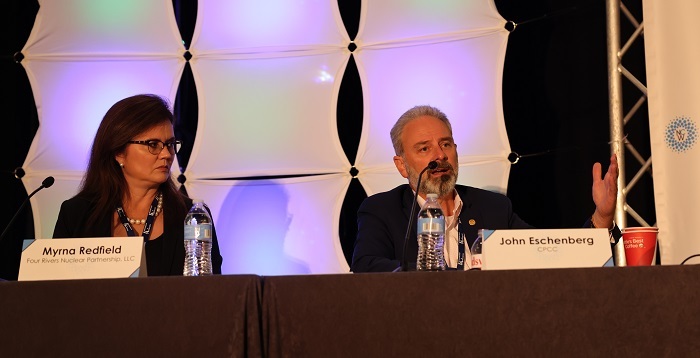 The "Developing the Future EM Workforce" panel at the National Cleanup Workshop included Myrna Redfield, president/CEO and program manager with Four Rivers Nuclear Partnership and John Eschenberg, president of Central Plateau Cleanup Company.
An inaugural EM Workforce Summit held Sept. 20 highlighted federal, contractor and stakeholder viewpoints on workforce challenges. Earlier this year, EM met with the organizations Energy Communities Alliance and Energy Facility Contractors Group to address near-term workforce pipeline challenges and science, technology, engineering and math (STEM).
Those discussions included how EM can “move the needle,” as Ellis described, in the next 18 months to better drive successful programs complex-wide and identify contracting obstacles.
At the National Cleanup Workshop, the panelists addressed issues such as the loss of employees who move on to more lucrative positions with better benefits like day care; industry competition; and the lack of a diversified talent pool.
“We’re all fishing from the same pond,” said John Eschenberg, president of Central Plateau Cleanup Company, EM Richland Operations Office contractor at the Hanford Site in Washington state. “It’s a short-term solution…It’s not a recipe for success.”
About 95% of EM’s annual budget is used to contract with an array of industry partners, according to EM’s 2022-2032 Strategic Vision.
Eschenberg stressed that the trades industry is in high demand in the Pacific Northwest, with positions such as radiation technicians, electricians, welders and others available.
“We got to get to these kids in elementary and seventh and eighth grade,” Eschenberg said. “It’s more about convincing their parents that it’s okay for their son or daughter not to seek a four-year traditional college diploma and instead serve the needs of industry and the needs for this country in a much different way.”
The Paducah Site in Kentucky has also seen a problem with attrition — at a 20% rate — among radiation technicians. That was before Myrna Redfield stepped in with training. The president/CEO and program manager for Four Rivers Nuclear Partnership, the EM Paducah Site deactivation and remediation contractor, said recent training success with United Steelworkers 550 at the Portsmouth Site in Ohio carried over to Paducah Site training as well, and now 17 people are ready to be radiation technicians at the Paducah Site.
The panelists agreed that inspiring a meaningful mission is a solution for retainment.
“We need them to want to work for us to change the world,” Eschenberg said.
-Contributor: Kim Kweder
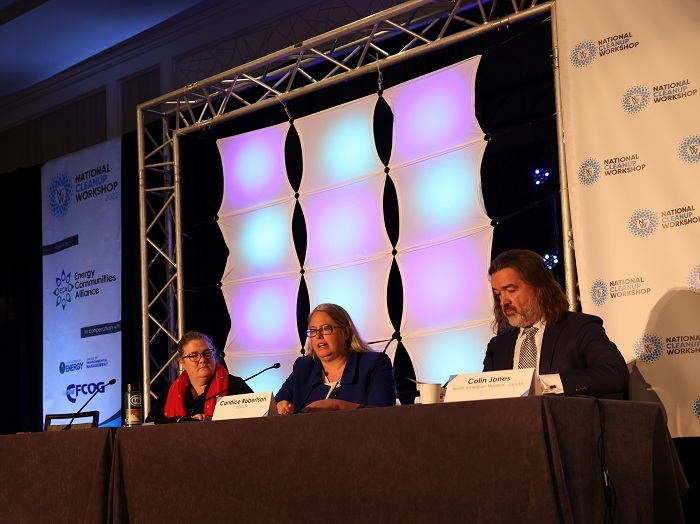 Participants in the "DOE Leadership Perspectives" panel at the National Cleanup Workshop included, from left, Betsy Forinash, deputy assistant secretary, EM Office of Waste and Materials Management; and Candice Robertson, EM principal deputy assistant secretary. Colin Jones, deputy general manager of North American Nuclear, Jacobs, served as panel moderator.
As EM looks ahead to advance its cleanup mission, leaders from various program offices shared their perspectives on past achievements, current progress and future challenges during a panel session at the National Cleanup Workshop.
Colin Jones, deputy general manager of North American Nuclear, Jacobs, moderated the panel session. Panelists included Candice Robertson, EM principal deputy assistant secretary; Randy Hendrickson, senior advisor, EM Office of Field Operations; Dae Chung, EM associate principal deputy assistant secretary for corporate services; and Betsy Forinash, deputy assistant secretary, EM Office of Waste and Materials Management.
The panelists were asked to assess the state of EM. The consensus was that the overall state of EM is strong. The cleanup program has made much progress, with many accomplishments at each EM site, but more work and challenges remain in the cleanup mission.
“It begins with the strong and steady leadership of Ike White,” who becomes the longest serving head of EM at the end of this month, Robertson said.
 |
|
Dae Chung, left, EM associate principal deputy assistant secretary for corporate services, and Randy Hendrickson, senior advisor, EM Office of Field Operations. |
The workforce continues to be a top leadership priority, according to the panelists, who discussed the challenges of retaining talent and recruiting new employees in EM.
EM’s Minority Serving Institutions Partnership Program (MSIPP) addresses the need for building and maintaining a well-trained, technically skilled and diverse workforce.
“MSIPP is extremely important for us, something to focus in on, and we need to put the effort behind it,” Hendrickson said.
Jones asked the panelists how EM will maintain the current mission while looking ahead to the future.
Forinash noted how EM takes a strategic view on interactions with regulators, stakeholders and tribes.
“We need to work with regulators so our success is their success,” Forinash said. She also stressed the importance of community relations and gaining a “real sense of partnership” in working with EM contractors in their investment in the communities.
Speaking from a corporate services viewpoint, Chung said, “We have to stay mindful of how we balance our resources and don’t lose sight of our priorities in key elements of our mission that are driving our lifecycle costs.”
Robertson closed out the session, noting one of the benefits of the recently unveiled EM Program Plan: “We are going to be able to add to it over the years by identifying more things for the program, while being transparent and having those conversations as we’re setting priorities.”
-Contributor: Keir-Kevin Curry
 Members of the panel titled “Maximizing Reuse Opportunities at EM Sites” included, from left, Randall Ryti, chair of the Los Alamos County Council; Jennifer Chandler, administrator of the Village of Piketon, Ohio; and Ken Rueter, president and CEO of UCOR.
EM partners near the Hanford, Los Alamos, Portsmouth and Oak Ridge sites highlighted reuse opportunities in the cleanup program during a panel session at the National Cleanup Workshop.
The discussion featured presentations by the panelists on their respective organizations’ roles in EM site reuse and economic development in their communities.
Moderated by Rick McLeod, president and CEO of the Savannah River Site Community Reuse Organization, the panel emphasized how EM and the many different organizations are involved in reuse and economic development.
Reuse may include everything from airports, ports, multiuse commercial space, residential development, recreational and open space, and infrastructure projects that create jobs, produce local assets, and generate revenue to put back into the community that would otherwise dissipate at the conclusion of the EM cleanup mission.
“The cleanup was not the end at East Tennessee Technology Park, but actually the beginning of a bright economic development and future,” said Ken Rueter, president and CEO of UCOR, EM’s cleanup contractor at Oak Ridge. “Ultimately, with the recognition of environmental cleanup… what is critical to all is that it is integrated with the end in mind.”

Diahann Howard, executive director of the Port of Benton, Washington state, speaks during a panel session on maximizing reuse opportunities at EM sites. Panel moderator, Rick McLeod, president and CEO of the Savannah River Site Community Reuse Organization, is at right.
|
Although the panelists are at varying phases of reuse in their communities, they shared challenges and lessons learned of the land-use transfer process. That process is most successful when the community’s needs and wishes for the desired end state are heard, and strong partnerships and collaboration occur at all levels.
“I have all the battle scars related to the land transfer process,” said Jennifer Chandler, administrator of the Village of Piketon, Ohio near the Portsmouth Site. The village is building the infrastructure and workforce development pipeline to support whatever type of end users come to Piketon.
“We are trying to do our part as best as we can to support redevelopment,” Chandler said.
Randall Ryti, chair of the Los Alamos County Council, showed the audiences photos.
“Here’s one of the projects that’s been recently completed, so starting back with an open space that was once a former fuel farm that got developed into an affordable housing project,” Ryti said. “That was a successful land transfer that was a cleanup project.”
Diahann Howard, executive director of the Port of Benton, Washington state, near the Hanford Site, provided the “bottom line” from her perspective.
“It’s about the hard stuff next, not just on the cleanup side, but on the communications and connections side — understanding where our community wants to go, working together and collaborating together,” Howard said. “I think it’s important to remember at the end of the day, it’s about service to our people, and that’s why we do what we do as local governments, for service of our people, our greatest asset.”
-Contributor: Karen Edson
 Participants on a panel titled “Entering a New Era for Hanford and the Tri-Cities” at the National Cleanup Workshop. Pictured, from left: Bob Wilkinson, Hanford Mission Integration Solutions president; Valerie McCain, Bechtel National Inc. project manager; Brian Vance, manager of EM’s Office of River Protection and Richland Operations Office; Steven Ashby, Pacific Northwest National Laboratory director; Wes Bryan, Washington River Protection Solutions president; and David Reeploeg, executive director of Hanford Communities.
Hanford Site leadership participated in a National Cleanup Workshop panel discussion focused on current and future achievements at the site.
EM Office of River Protection and Richland Operations Office Manager Brian Vance guided contractor, community and laboratory leaders in speaking on important site transitions as Hanford approaches the start of tank waste treatment. The panel also discussed the site’s effect on communities in and around the Tri-Cities.
Panelists focused on the cleanup mission and progress toward the start of Direct-Feed Low-Activity Waste operations while using the successful One Hanford approach.
“The Department of Energy (DOE) and One Hanford contractors work as a team to safely deliver cleanup progress that reduces risks to the workforce, the community and the Pacific Northwest,” said Vance.
The One Hanford approach has created the communication, collaboration and teamwork necessary to support the next phase of the cleanup mission. The Hanford workforce is preparing for 24/7 operations as an integrated team, establishing an environment that sets the course of cleanup for decades to come.
Each site contractor that participated in the panel gave progress updates on projects at Hanford. The panel then shifted its focus to how the One Hanford team is expanding its partnerships at local, state and federal levels.
 |
|
EM Office of River Protection and Richland Operations Office Manager Brian Vance addresses the audience during a National Cleanup Workshop panel titled “Entering a New Era for Hanford and the Tri-Cities.” |
“As we look to the future, the next chapter of our DOE and Tri-Cities partnership is built on continued cleanup excellence and clean energy development and commercialization,” said Vance.
The long-term collaboration created from the transition of cleanup to clean energy is likely to include a range of missions. The One Hanford team will need to attract the next generation of workforce, while maintaining the same level of excellence within the Tri-Cities, a community known for its long history of delivering successful outcomes for the nation through teamwork and innovation.
“While the Hanford cleanup mission will continue for decades, the One Hanford approach will remain an important foundation for the continuing prosperity of the Tri-Cities,” said Vance.
-Contributor: Cerise Peck
|